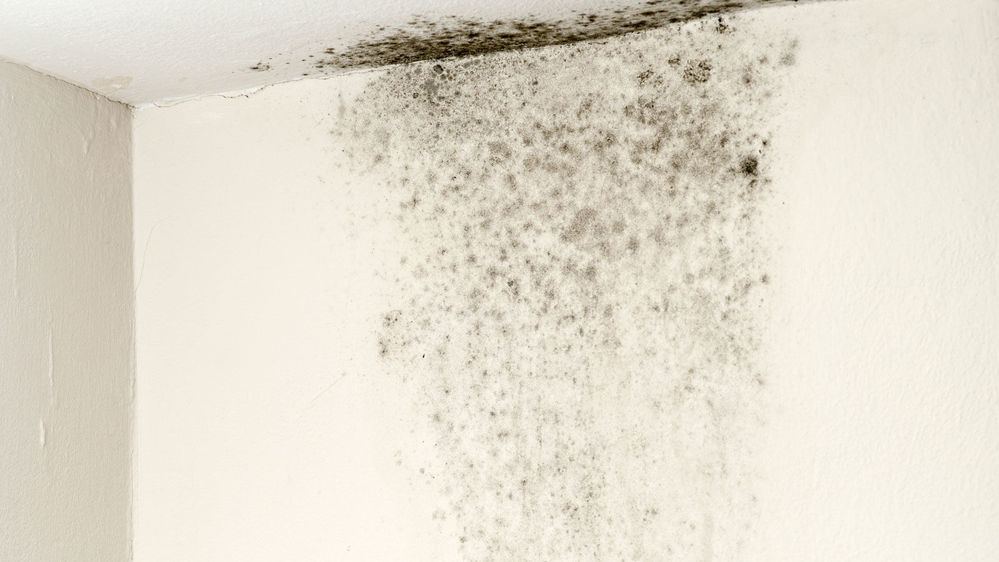
Black mould on interior walls can be a real problem for millions of homeowners across the UK, but what causes it and have can you prevent it long-term? In this guide to black mould on walls we are going to cover everything you need to know, including the primary causes and potential treatments, so you can wave goodbye to mould & damp problems for good.
What Is Black Mould?
Mould, or more specifically black mould, is a highly common problem experienced by the UK housing stock. Black mould is directly a result by excess levels of moisture within a property, caused by any number of sources.
Black mould appears in the form of small black spots of mould that appear in certain areas that are particularly prone to mould growth. These areas are where there is poor ventilation such as behind furniture, in high-moisture rooms such as bathroom or kitchens and on the walls of rooms that have cold spots, such as external facing walls.
What Causes Black Mould Growth?
To put simply, the cause any mould growth on interior walls & ceilings is excess levels of moisture. Black mould requires this moisture in order grow, meaning high levels of humidity can create the ideal conditions for the mould to bloom and eventually multiply.
This moisture can be created by any number of sources, including:
- Leaks from appliances, roofs, windows and plumbing can all lead to moisture saturating the fabric of a property.
- Contrary to popular belief, exterior walls are porous, meaning they will absorb moisture over-time. This moisture is then transferred into the property causing high levels of moisture. This process is known as penetrating damp and is one of the most common forms of black mould growth on walls.
- Water from the ground can be absorbed up through the walls of a property in a process known as rising damp. A damp proof course (DPC) is designed to protect from this, however if this is failing then the moisture from the ground will simply soak into the bottom-level of a property and continue to rise up the external and internal walls.
- Condensation is created through the day-to-day living within our homes, from dryers, washing machines and showers, to name a few. When warm, moist air comes into contact with colder surface temperatures, the water is released causing condensation to form.
While all of these will contribute to moisture levels, they are unlikely to all be present in your home. That is why it is crucial to identify what exactly may be leading to higher moisture levels so you can find a long-term solution.
Inspecting your property is the first step you should take towards finding a solution to any black mould problems. Evaluate the areas where you are suffering from mould or damp problems. Any leaking gutters, roofs or signs of plumbing is the first thing to keep an eye out for. If you are suffering from damp, try and identify whether the damp is rising up from the ground or whether it is absorbing through the external wall of the property. Penetrating damp can occur at any level of the property, while rising damp must start at the very bottom and work its way up the wall. Other ways to identify whether it is penetrating damp is any signs on the exterior wall of wetting, discolouration or damage such as cracks and damaged brickwork. These can all help to establish whether moisture is attacking the external wall and allowing this moisture to travel into the property.
If none of these signs and present, then it is likely that the source of the moisture in condensation, especially if the black mould is gathering on walls that have poor ventilation.
What Problems Does Black Mould Cause?
As well as the problems caused by black mould, there are also a number of problems that are caused from high levels of moisture in a property.
- Black mould on walls can cause a number of health problems. As stated on the NHS website, "if you have damp and mould in your home you're more likely to have respiratory problems respiratory infections, allergies or asthma". The elderly, young children and those with existing medical conditions can be particularly prone to problems associated with black mould, although any inhabitant of a property with mould problems is likely to be negatively affected.
- High levels of moisture will lead to bubbling paint or wallpaper peeling.
- Black mould growth can leave a damp, musty smell in rooms which can be unpleasant.
- Other sources of moisture such as penetrating damp can be a sign of other structural problems in your property, such as cracked exterior walls which over-time will worsen.
How Do You Prevent Black Mould?
In order to prevent the growth of black mould on walls & ceilings, you must prevent the source of the moisture that is allowing it to grow. As we have previously mentioned, it is crucial to identify any potential sources of moisture in order to find the most suitable solution for the problem.
If you have identified that rising damp may be the cause of black mould growth, then you will need to ensure that you have a working DPC on your property. if there is no DPC or it is failing, you must apply a damp proof injection cream into the bottom layer of the property which creates a water-resistant barrier between the bricks and the ground. This is a difficult project to undertake yourself, so we recommend contacting a damp expert who can carry out the work for you.
When it comes to finding a solution for penetrating damp, you must provide the external wall waterproofing properties in order to prevent water ingress on the masonry. There are two treatments that are effective at preventing penetrating damp; masonry cream and waterproof masonry paint. Emperor Masonry Creme is a clear treatment that creates a super hydrophobic (ultra water-repellent) surface on exterior brick, stone and concrete walls that does not alter the appearance. Unlike a brick sealer, masonry cream remains highly breathable, ensuring that any water vapour from condensation can naturally breathe through the wall, while moisture from rainfall stays out.

Emperor Masonry Paint contains the same super hydrophobic technology as Emperor Masonry Creme, however it offers a coloured, painted finish available in 12 popular exterior colours. The highly breathable, water repellent properties of the paint mean that it never peels or flakes, as moisture is primary cause of paint failure. This is why peeling paint is often a sign of moisture problems within a property.
This weather protection provides the paint with unrivalled durability, with a 25+ year proven performance in harsh weather conditions and a lifetime guarantee.
_1000.png)
For condensation, which is likely to be a primary cause of black mould on interior walls & ceilings, there are a number of ways you can take to reduce the growth of mould.
Firstly, it is important to take some quick & easy steps to reduce the amount of condensation that can gather with the property. These include:
- Improving the ventilation in your home by opening windows, although this may not always be possible, especially in winter months
- Avoid placing wet clothes on radiators
- Leave a gap between furniture and the wall, to allow for better airflow
- Use extractor fans in kitchens where possible to allow condensation that builds in kitchens to escape the property
While these measures can all help to reduce the amount of condensation, they are not always feasible all year round. When it comes to treating condensation long-term, the best way to do this is use an anti-condensation paint. There are a number of terms that you will see when looking for condensation and black mould treatments, including 'anti-condensation paint', 'anti-mould paint' and 'anti-damp paint'.
It also acts to reflect this heat back into the room, helping to keep a warmer ambient temperature and improve the energy efficiency of the room. The thermal performance of the paint means that it does not have to work on the surface of the wall, meaning you can wallpaper or paint over the surface to decorate the room as you wish.
Frequently Asked Questions
Q. WILL BLACK MOULD ON WALLS REDUCE OVER-TIME?
Black mould on walls & ceilings will only begin to reduce when you prevent the source of the moisture that is allowing it to grow. Whether this is from penetrating damp or from condensation, the best way to remove black mould and prevent it from re-appearing is to apply a treatment that will prevent the moisture.
Q. HOW DOES APPLYING A TREATMENT IMPROVE THE ENERGY EFFICIENCY OF A PROPERTY?
No matter what type of property your home is, the chances are you will suffer from some level of damp, either from penetrating damp soaking into the external walls of your home or from condensation build-up.
The science behind this is that wet walls transfer heat 50% quicker than dry ones. With 35% of heat being lost through the walls of a property, by keeping walls warm you help in reduce the amount of heat they transfer and ultimately improve the thermal performance of a home.
For penetrating damp, by preventing the external wall of a property from getting saturated from rain water, you improve its thermal performance. In independent testing conducted by a UKAS accredited laboratory, Emperor Masonry Paint and Emperor Masonry Creme were found to keep a brick wall up to 6°C warmer on average compared to an untreated masonry wall. This is because the water repellent properties prevented water coming through the wall, plus the high breathability ensured that no moisture became trapped within the wall. Following the evidence from the testing, both products were verified by the Energy Saving Trust.
Q. IS BLACK MOULD A STRUCTURAL ISSUE?
In short, black mould requires moisture, so while it doesn't directly cause structural problems itself, it is an indicator that there is moisture present which can cause these issues. Penetrating damp for example can cause peeling paint, crumbling mortar, spalling bricks and cracked masonry, which can all impact the integrity of the property.
For this reason, it is highly recommended that you resolve the moisture issue as soon as possible as this will limit the damage it can do to your property.
We hope we have answered any questions you may have had regarding black mould and how to treat it. If you have any other questions or would like advice identifying what the best solution for you is, feel free to get in touch with our team of experts who are on hand to assist you. Contact them today by emailing info@emperorpaint.co.uk or calling them on 0161 509 9009. Alternatively, shop our range of products today and get free next working day delivery on all orders over £50.

